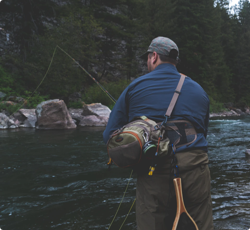
Catching Salmon at “Buoy 10”
Buzz Ramsey and Joe Thomas with a Buoy 10 Chinook When it comes to salmon fishing in the Pacific Northwest, it’s the Columbia River that produces the most for sport anglers. And, of the three major runs of salmon returning to the Columbia, it’s the fall run that is the most plentiful and expected to number a million strong this year. It’s at the Columbia River mouth, referred to as “Buoy 10” by anglers, where you can catch a limit of hard-fighting salmon fresh in from the Pacific Ocean. The season runs August through September for Coho, with the last three weeks of August the peak time for Chinook. The red number ten navigation marker is the western boundary of the fishery management zone known as "Buoy 10". Realize the waters just west of the number ten buoy, known as the Columbia River Control Zone, are closed to sport fishing. While Buoy Ten marks the western boundary, the eastern boundary extends from the navigation light at Oregon’s Tongue Point through red channel marker 44 and on to Rocky Point on the Washington shore. This fourteen mile section is where the fall salmon stage before starting their upriver journey. The basic concept of where salmon can be found with each tidal movement is pretty simple, really; fish wanting to enter the big river collect at the river mouth when the tide is outgoing (ebbing) and move into the estuary as the tide floods eastward. So the best fishing at low tide and the beginning of the flood is at or near the western boundary. As the flooding tide builds, the fish (perhaps a massive wave of fish) move eastward with it. At or near the top to the tide, the majority of the salmon can be found near or above the Astoria Megler Bridge. A tide book or smart phone app (I use Fish Head) can provide you with the timing of the tide swings and tell you the amount of change from low to high in feet. This is important because a big tide will push more fish further into the estuary in which case many will move upriver, while a low exchange will cause fish to accumulate in the estuary and linger in that area longer. A small tide exchange is when the difference between high and low tide is seven feet or less. Each day the best bite will likely occur during the last half of the flood and first half of the outgoing tide. This is when you will find most fish in the area extending from the west tip of Desdemona Sands eastward past the Astoria-Megler Bridge. During the latter half of the flood you should be trolling upriver, the same direction as the flooding water. One strategy is to troll the North Channel near Desdemona Sands in 20-to-30 foot of water and make mile long tacks upriver trolling well past the bridge as the flood tide is nearing its peak. Once the tide changes direction and begins to ebb, you’ll need to turn your boat around and troll westward, making mile long tacks before picking up your gear and running upstream to start another downstream troll. Flashers, like Big Al’s Fish Flash, are popular at “Buoy 10” because they attract fish by producing horizontal, strobe-like flashes of light as they spin. Fish Flash attracts fish without the drag associated with other flasher or dodger types. The Fish Flash triangular shape and wings that extend outward make it work when attached directly to a diver. When used in combination with a sinker rigged on a dropper line, it’s best to attach your weight to a free-sliding spreader; that way should your sinker become tangled in the net as the fish nears the boat he won’t break you off should he make another run. Herring is the most popular bait type at “Buoy 10” and is available in different sizes (identified by the color of the package label) with “Blue Label” being the most popular. Try rigging your herring on a 5-to-6 foot mooching leader consisting of two 4/0 size single hooks, like the one Owner designed just for use with herring. Fishing Tip: When using herring, it’s important to not move your rod when a salmon starts mouthing your bait. The initial bite may be so light, in fact, you might think your gear is rubbing bottom; don’t move your rod! Let the fish mouth your bait and pull your rod tip down three-to-four times before setting the hook. Spinners produce salmon just as well and sometimes better than herring, with the larger sizes (like the 5-1/2 or 6-1/2 Toman or Mulkey squid spinners being the most popular. The most popular spinner colors include Red & White, Chartreuse/Green Dot, Pearl Red Dot and Mexican Flag. Rigging Tip: Positioning a swivel halfway down your leader will eliminate leader twist associated with fishing a spinner or spinning bait. A popular rods series for fishing “Buoy 10” are the Berkley Air rods in casting lengths ranging from 9 to 10’6” in length combined with a line-counter reel like the Penn Warfare filled with 25-pound test Big Game monofilament or 40-to-65 pound test Tracer Braid or Spiderwire super braid.





